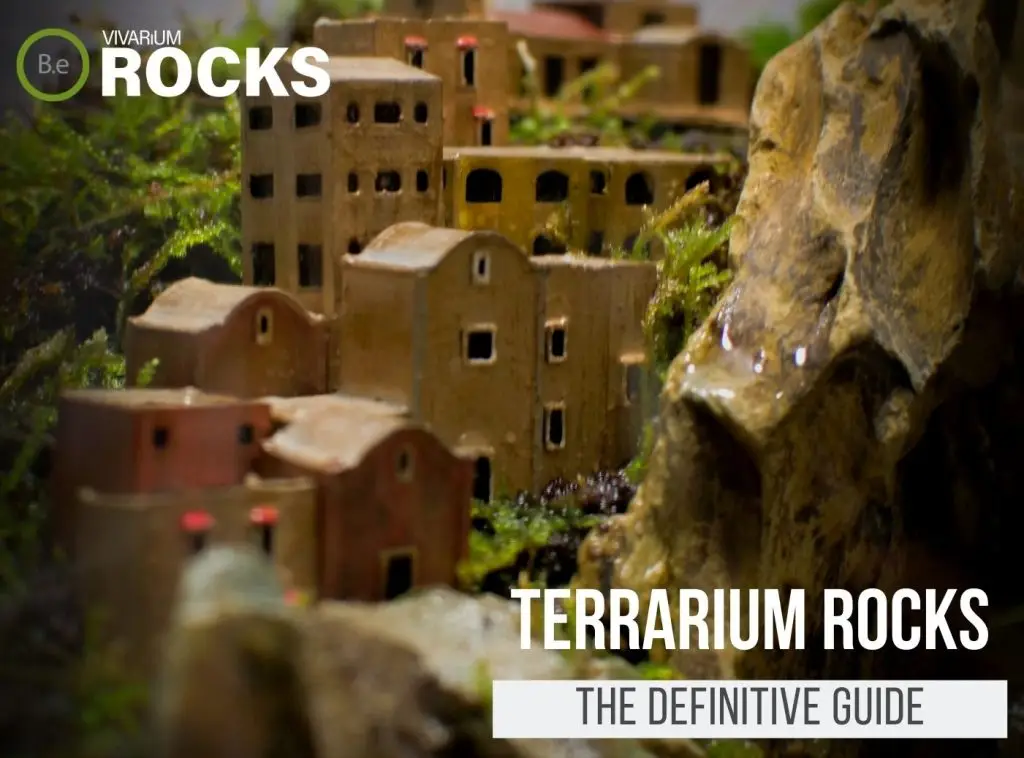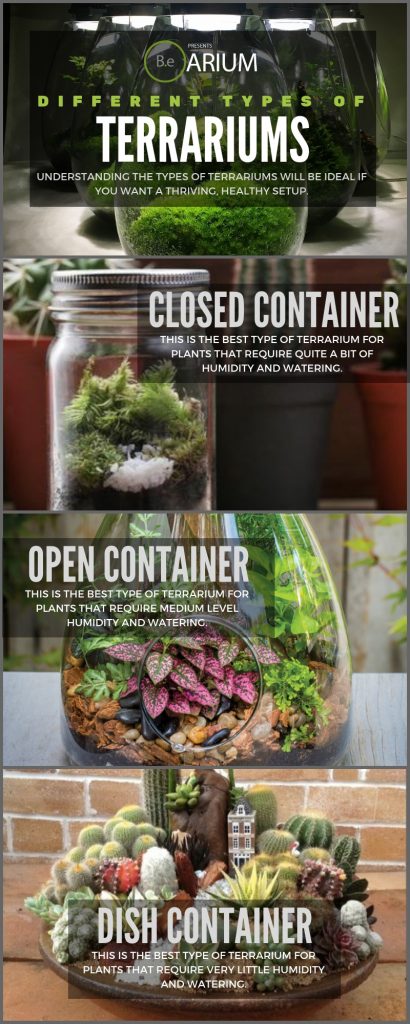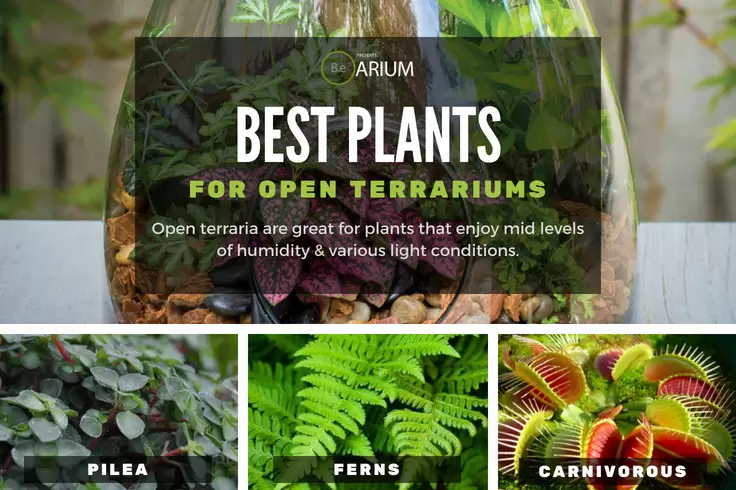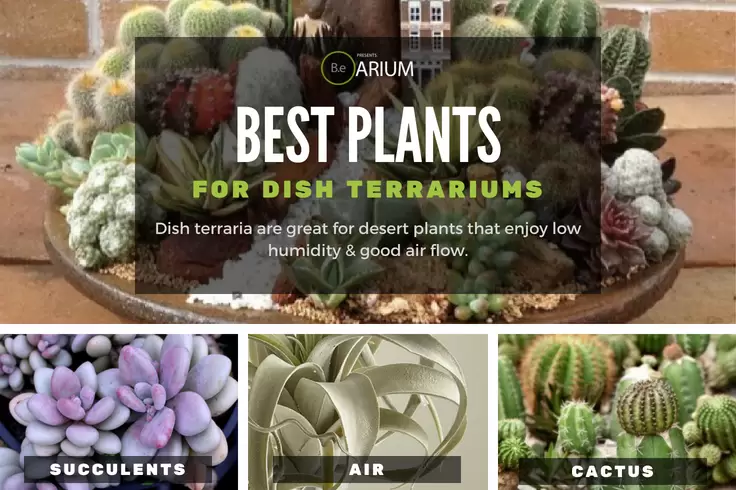Today we explore man’s miniature wonder garden… the terrarium! As usual, we’ll cover what they are, how to make one & the different types that can be established. These have become extremely popular lately for the simple fact that they’re easy to maintain, visually refreshing, and fun to make!
Table Of Contents:
ToggleWhat is a terrarium?
A terrarium, a common type of vivarium, is a clear enclosure used to grow plants. The prefix terra is Latin for “land” or “terrain.” As you might imagine, the word in itself translates to “land within a container.” Another word for terrarium commonly used in the hobby is terraria, which is used when there is more than one.
These can be used for decorative purposes or with the intent to house vegetation. Terrariums come in all shapes and forms, but usually never house anything other than plants and elements meant to aid in the growth of that particular plant.
The History Of Terrariums
In the mid-1800s, a botanist by the name of Nathaniel Bagshaw Ward stumbled upon terrariums by accident. His fascination with the transformation of moths led him to the idea of placing cocoons in jars of soil for observation.
One day, he noticed that one of the jars began blooming. Upon closer look, he noticed a small bit of fern and grass began to sprout from the damp soil. This led Ward to write a book that documented the conception of the terrarium, which would later become extremely popular in England.


Throughout the Victorian era, terrariums became common. At the time, they were referred to as Wardian Cases and were used mostly to transport invasive plants long distances across Europe. Carpenters were hired to construct the housing used to make these enclosures during these days.
Terrarium vs Vivarium: What is the difference?
Terraria and vivaria are very similar in the way they are designed. They both house a type of flora along with elements to support those plants. However, only one (vivarium) involves one or more types of inhabitants.
A terrarium doesn’t house live animals. The moment you introduce any type of animal into a terrarium and it becomes established, that enclosure becomes a vivarium.
It is safe to say a terrarium can’t be bioactive. Having Springtails or Isopods added to the substrate of your habitat to help keep the environment thriving adds the “live” aspect to the terrarium, therefore making it a vivarium.
Building A Terrarium
We can now take a look at how to make a basic terrarium. There are three main parts to consider when building this type of enclosure. After that, you must consider the lighting! No matter how complex your terrarium plan is, it should always consist of these key layers.


The Substrate Layer
Two layers make up the substrate which is very important to consider, the drainage layer and the soil layer. The drainage layer usually consists of some type of earthy material, like gravel, rocks, and activated charcoal.
This area is important because it provides an easy way for stagnant water to escape the reach of flora roots in the potting layer. Allowing water to settle down here helps keep the humidity levels stable within the enclosure.
This layer also serves as a good spot for healthy bacteria to thrive and break down unhealthy chemicals like ammonia.


The soil layer of the terrarium is made up of some type of growing media and the roots of the plants. In most cases, it contains soil like coco coir or potting mix. You will want something that is easy for plants to root through.
The material should also hold moisture well. Healthy bacteria reside in this layer and aid with the breakdown of nutrients that the plants will absorb.


The Hardscape Layer
The hardscape is also an essential layer to consider for the terrarium. It is the foundation of the tank and will regulate the overall ecosystem depending on the type of material it is. This can either be composed of rock or wood.
Even though the substrate will be put down into the enclosure first, the hardscape should be decided before any other elements are considered. Learn more about the importance of hardscaping in this article if you need help choosing the right types of material for your specific build.


The Plant Layer
This layer of the terrarium is the centerpiece of the enclosure. This layer comprises the ground cover, upper parts of the given terrarium plants (stem, leaf & flower), and any decorations you would like to showcase along with the plants.
The ground cover is meant to help keep moisture in the substrate. It can include things like leaf litter or a particular type of moss. The type of plants and decorations will vary based on the type of terrarium you are making.


The Lighting Layer
This layer is a very important aspect of a terrarium. In fact, it is probably the single most important feature! Without light, your plants will not be able to produce energy from photosynthesis.
You can use direct/indirect sunlight or artificial lighting. I recommend LED lighting, but you can also use fluorescent lighting as well.
Different Types Of Terrariums
There are a variety of ways one could build a terrarium. Understanding the types of terrariums will be ideal if you want a thriving, healthy setup.
Furthermore, you will have to decide on what you will keep in this enclosure and what will be the requirements. In other words, how much water will those plants require to survive?


Closed Container Terrariums
A closed container is the best type of terrarium for plants that require quite a bit of humidity and watering. This enclosure requires all three key features we talked about earlier. As far as lighting goes, I recommend artificial lighting or indirect sunlight.
One good thing about this type of build is that it won’t require much watering. The plants release water vapor. As the vapors rise, they become trapped in the glass and fall back down to the substrate.
The plant recycles the water down to the roots. However, this type of sealed enclosure tends to fog up parts of the glass, ultimately disrupting the view of the terrarium.
Open Container Terrariums
This is suitable for a wider variety of plants than the other two containers. Even with the overall humidity being lower than in a closed container setup, you have much more control over the moisture levels by just adding or removing water.
This type of arrangement also requires all three key features. Artificial lighting, direct sunlight, or indirect sunlight will suffice for this setup.
It’s a good idea to add a drainage plug for easier water removal. This type of structure can be used as either a dry or wet terrarium. The only con with this kind of container is it may require a bit more maintenance than the other two.
Dish Container Terrariums
These are by far the easiest to build and manage. This type of terrarium is a low-humidity setup and requires very little to no watering. Dish terrariums often don’t require all three key features.
On many occasions, the drainage & substrate layers are one and the same. In fact, if you are building a terrarium that only houses air plants, you can get away with eliminating those two layers entirely!
There aren’t many disadvantages when it comes to the maintenance of a dish container terrarium. Any type of lighting will work well with this setup. You can set and forget this type of enclosure!
Terrarium Care Tips
The greatest part about having a terrarium is the fact that they don’t require much maintenance. Depending on the type of arrangement you build, you may not have to do anything at all.
Like dish containers, you more than likely will have some sort of air plant or succulent on it. Air plants get their needed nourishment from the vapors in the air, and succulents require very little watering. You can water them as little as once or twice a month!


Closed containers will need some light trimming done annually to keep the intended look of a neat setup. But even that is a matter of preference. You might be going for a natural, overgrown look in your terrarium that doesn’t require any human tampering.
In that case, adding water might be the only requirement from time to time.
Open containers tend to require the most TLC, but will still be pretty low maintenance for the most part. Trimming away brown and yellow parts of the plants will be something to do, as it can be a sign of disease.
Since the terrarium is open, you will have to keep an eye out for uninvited pests. Small flies can lay eggs and cause larvae to inhabit this type of enclosure. You will need to remove and treat your open container for any sign of pest invasion. These guys can munch away at your livestock, or worse, cause disease in your flora.
Best Type of Plants for Terrariums


These types of terrariums have a lid or cover over them and restricted airflow. Closed enclosures are great for high humidity-oriented plants like Moss, Bromeliads, or Ivy plants. These plants typically like indirect sunlight or shade, peat soil, and watering weekly or bi-weekly.


These types of terrariums have one side of the enclosure open and some airflow. Open container terraria are best used for plants that like to dry out completely after watering like Ferns, Pilea & Carnivorous plants. These plants typically like indirect sunlight and weekly watering.


These types of terrariums have no sides or lids on them and a lot of airflows. Dish terraria are great setups for low humidity flora that require good airflows like Air plants, Succulents, or Cactus. These plants tend to like bright, direct sunlight.
Best Terrarium Kits
Terrarium kits are great for those looking for a complete set to kick-start their hobby. In most cases, a kit will come with everything needed to make your very own terrarium. If you are looking for terrarium kits you can buy with everything needed to get started on a project, here are a few editor’s picks we recommend taking a look at:
Terrarium Kits For Kids


Terrarium Kits For Kids are beginner-friendly kits that come complete with everything needed to make your very own terrarium. The neatest feature of this kit is how it lights up at night. I’d recommend this to anyone looking for a crafty project and not just children.
Succulent Terrarium Kits


Succulent Terrarium Kits are great for those looking to make something that doesn’t require a lot of maintenance. This kit comes with everything needed to start your very own fairy garden. Easily add low-humidity plants of your choice like succulents, air plants, or cacti.
Closed Terrarium Kits


This Closed Terrarium Kit is great for an intermediate hobbyist looking for a classic take on a terrarium build. This vintage Wardian case is perfect for you if you want to grow higher-humidity thriving plants like orchids or moss. This kit gives you total creative control over the type of substrate and plants you would like to place in it.
Vivariums Similar To A Terrarium
The many other types of vivariums you will see out there are more than likely based on one of these core designs. If you are building a vivarium with the intention of housing a specific type of plant or animal, be sure to go with a design that closely fits their needs.
If you enjoyed this type of content, be sure to check out some of the other popular types of enclosures we’ve covered in the past:
Conclusion
A terrarium can be a fun and simple project to make. Keep a mini greenhouse in your kitchen for super fresh herbs or add some earthy decoration to your living space. These miniature gardens are excellent additions to your home. What type of plants do you currently have or plan to have in your terrarium?
Frequently Asked Questions
Terrariums stay alive by providing the conditions necessary for the plants and animals within to thrive, such as adequate light, water, and ventilation.
Terrariums can last indefinitely if they are properly cared for. Regular maintenance such as trimming dead leaves, providing adequate humidity, and checking for pests are important for a long–lasting terrarium.
Yes, a terrarium can be self–sustaining if it is properly designed and maintained.
A self–sustaining terrarium should include living plants, substrate, and bacteria, and should be kept in the right environment for the plants and bacteria to thrive. Additionally, the terrarium should be well–ventilated to provide oxygen and humidity.
Charcoal is used in terrariums to help keep the air clean and balanced. The charcoal absorbs toxins and odors and also helps to keep the terrarium environment healthy by providing essential minerals and maintaining a proper pH level.
Yes, tap water is generally safe to use for terrariums. Just make sure to remove any chlorine from the water before using it. Also, use a nitrate and phosphate–free water conditioner to help ensure your terrarium water is safe for your plants and animals.
You should open your closed terrarium every 2–3 weeks to allow air to circulate and prevent mold or fungus growth.
No, terrariums do not need light 24/7. They should be exposed to light 10–12 hours per day.
You will need a terrarium container, substrate, plants, and decorations to create a terrarium. You may also need additional gravel, water, tools, moss, activated charcoal, and pest–control products, depending on what type of environment you want to create in your terrarium.
A terrarium is a sealed container that allows an enclosed environment in which plants can grow. It provides the necessary humidity and moisture for the terrestrial plants to thrive, and can also help to create air circulation to keep the plants healthy.
Many animals that are staples in bioactive terrariums (such as bearded dragons, leopard geckos, or dart frogs) can feed on mold, as can most insectivorous species. In addition, some species of isopods and springtails can consume mold and help keep it under control.
The main difference between a vivarium and a terrarium is that a vivarium is used to house living animals, whereas a terrarium is primarily used to house plants. Vivariums typically include a heating and cooling system, while terrariums may not. Additionally, while terrariums can often be made with any type of container, the walls of a vivarium need to be quite thick to provide temperature regulation and maintain the correct environment for the animals living inside.




Comments are closed.